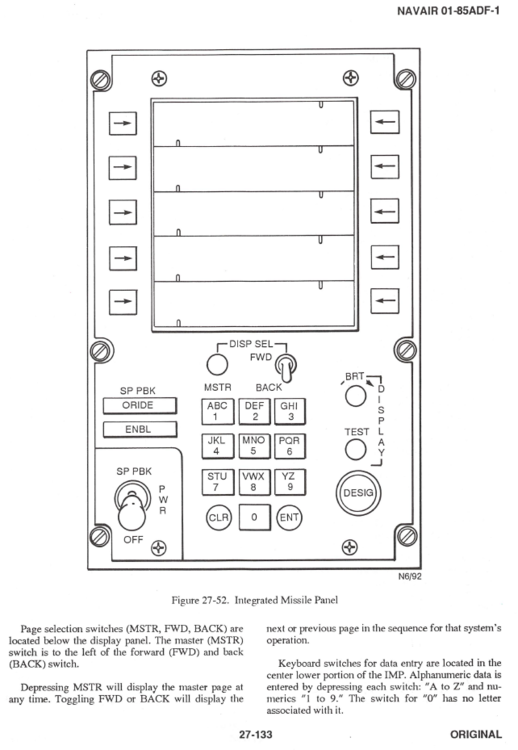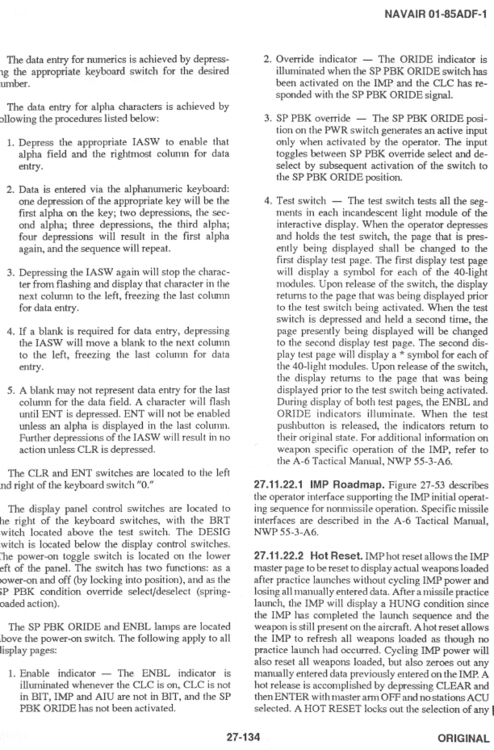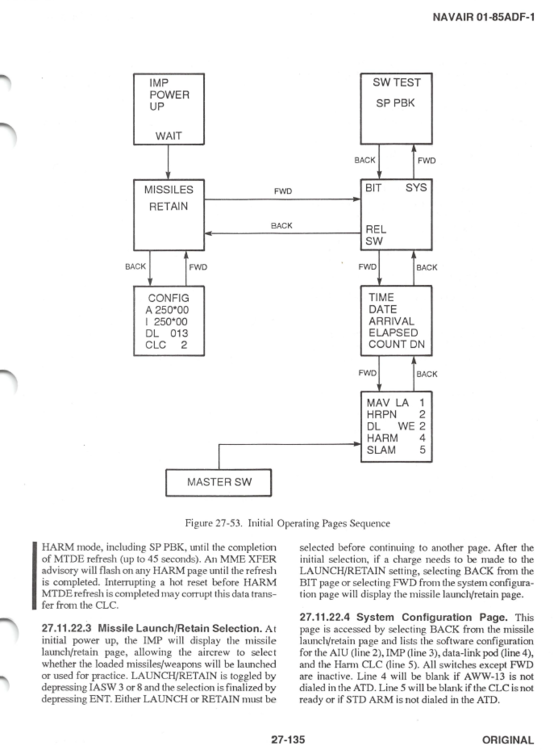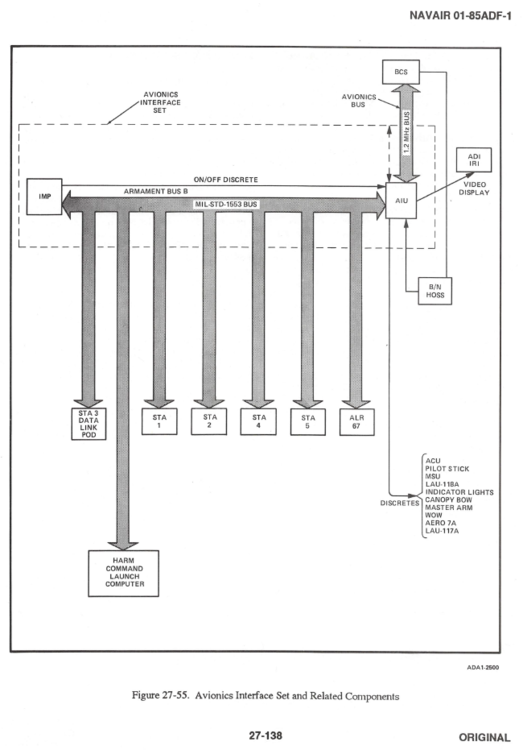-
Posts
113 -
Joined
-
Last visited
Content Type
Profiles
Forums
Events
Everything posted by Iron_physik
-
Hello all! The AIM-7 Sparrow (Airbourne Interception Missile) is a radar guided air to air missile, it used alongside the famous AIM-9 sidewinder and also infuenced aerial combat quite alot. it was the forefront of todays BVR combat. In the begining and a brief explaination of how the AIM-7 works unlike the AIM-9 sidewinder, the AIM-7 uses radiowaves to guide to its target, im going to explain how its done: The Sparrow Evolution and Performance Thanks to MacedonianSukhoi for the image. -------------------------------------------------------------------------------------------------------------------------- AIM-7A - Sparrow I The history of the Sparrow missile dates back to 1947, when the U.S. Navy contracted Sperry to develop a beam-riding guidance system for a standard 12.7 cm (5 in) HVAR (High Velocity Aerial Rocket). The original designation for this missile project was KAS-1, but this was changed to AAM-2 in September 1947 and to AAM-N-2 in early 1948. The 5" diameter soon proved to be too small, so Douglas developed a new airframe of 20.3 cm (8 in) diameter. The first unpowered flight tests of XAAM-N-2 prototypes occurred in 1948. Development was difficult, however, and the first successful air-to-air interception was only done in December 1952. The AAM-N-2 Sparrow I entered service in 1956 with F3H-2M Demon and F7U-3M Cutlass fighters. Because of the inherent disadvantages of beam-riding guidance, like poor low-level performance, only 2000 Sparrow I missiles were produced, and it was withdrawn from service after only a few years. Another drawback of the AAM-N-2 was that the guidance beam was slaved to an optical sight in the aircraft, which necessitated visual identification of the target, making the Sparrow I a short-range VFR missile only. Performance AIM-7A Length: 3.74 m (147.3 in) Finspan: 0.94 m (37 in) Diameter: 20.3cm (8 in) Weight: 143 kg (315 lb) Speed: Mach 2.5 Propulsion: Aerojet 1.8KS7800 solid rocket Thrust: 7100lbs (3220kg) for 2.04sec Guidance duration: N/A Warhead: 20 kg (45 lb) EX25 Mod.0 warhead with 4.2kg (9.25lbs) of H.6 Detonation distance: 7.6m (25ft) Guidance type: Beam Riding Maneuvering capability: N/A Max Launch velocity: Mach 1.3 -------------------------------------------------------------------------------------------------------------------------- AIM-7B - Sparrow II Because of the above noted principal problems of the AAM-N-2, new guidance methods were searched almost from the beginning. As early as 1950, Douglas studied the possibility of equipping the Sparrow with a active radar-homing seeker. By 1955 Douglas proposed going ahead with development, intending it to be the primary weapon for the F5D Skylancer interceptor. It was later selected, with some controversy, to be the primary weapon for the Canadian Avro Arrow supersonic interceptor, along with the new Astra fire-control system. For Canadian use and as a second source for US missiles, Canadair was selected to build the missiles in Quebec. The small size of the missile forebody and the K-band AN/APQ-64-radar limited performance, and it was never able to work in testing. After considerable development and test firings in the U.S. and Canada, Douglas abandoned development in 1956. Canadair continued development until the Arrow was cancelled in 1959. Performance AIM-7B Length: 3.65 m (144 in) Finspan: 1.02 m (40 in) Diameter: 20.3cm (8 in) Weight: 190 kg (420 lb) Speed: Mach 2,67 Propulsion: Aerojet 1.8KS7800 solid rocket Thrust: 8000lbs (3628kg) for 1.84sec Guidance duration: N/A Warhead: 20 kg (45 lb) Detonation distance: 7.6m (25ft) Guidance type: Active Radar Homing (ARH) (active) Seeker range: 12km (6NM) Aerodynamic Range (50kft alt): 28km Maneuvering capability: 20g Max Launch velocity: Mach 1.3 -------------------------------------------------------------------------------------------------------------------------- AIM-7C - Sparrow III After the failure of the Sparrow II program other ways of guidance where considered. The development of the modern sparrow started in 1955 by raytheon. The Sparrow III and all subsequent versions of Sparrow used semi-active radar homing. After tests with YAAM-N-6 R&D missiles, production of the tactical AAM-N-6 began in January 1958, and it entered service in August 1958. The missile had an Aerojet solid-fueled rocket motor, and a 30 kg (65 lb) MK 38 continuous-rod warhead. Performance AIM-7C Length: 3.66 m (144 in) Finspan: 1.02 m (40 in) Diameter: 20.3cm (8 in) Weight: 172 kg (380 lb) Speed: Mach 4 Propulsion: Aerojet 1.8KS7800 solid rocket Thrust: 7100lbs (3220kg) for 2.04sec Guidance duration: 75 sec Warhead: 30 kg (65 lb) MK 38 continuous rod with 9kg (20lbs) of PBXN-4 Detonation distance: 7.6m (25ft) Guidance type: Semi Active Radar Homing (SARH) Seeker range (200W radar output): 12 km (6.5 NM) Aerodynamic Range (40kft alt): 18 km (10 NM) Maneuvering capability: 16g Max Launch velocity: Mach 1.3 -------------------------------------------------------------------------------------------------------------------------- AIM-7D Sparrow III The AAM-N-6a (AIM-7D) was similar to the -6, but used a new Thiokol liquid-fuel rocket engine for improved performance. It also included changes to the guidance electronics to make it effective at higher closing speeds. The -6a was also selected to arm the Air Force's F-110A Spectre (F-4 Phantom) fighters in 1962, known to them as the AIM-101. It entered production in 1959, with 7500 being built. Performance AIM-7D Length: 3.66 m (144 in) Finspan: 1.02 m (40 in) Diameter: 20.3 cm (8 in) Weight: 197 kg (435 lb) Speed: Mach 4 Propulsion: Thiokol MK 6 MOD 3 (LR44-RM-2) liquid-propellant rocket motor Thrust: N/A Guidance duration: 75 sec Warhead: 30 kg (65 lb) MK 38 continuous rod with 9kg (20lbs) of PBXN-4 Detonation distance: 7.6m (25ft) Guidance type: Semi Active Radar Homing (SARH) Seeker range (200W radar output): 15 km (8.3 NM) Aerodynamic Range (40kft alt): 44 km (24 NM) Maneuvering capability: 15g Max Launch velocity: Mach 2.2 -------------------------------------------------------------------------------------------------------------------------- AIM-7E Sparrow III In 1963, production switched to the AIM-7E version. It used a new propulsion system, a solid-fueled rocket by Rocketdyne (either a MK 38 or later a MK 52). The new motor again significantly increased range and performance of the missile. Effective range of course depended greatly on firing parameters like launch speed and relative velocity of the target. In head-on attacks under optimal conditions, it could be as high as 35 km (20 nm), while in stern attacks, maximum effective range was more around 5.5 km (3 nm). About 7500 AIM-7D and 25000 AIM-7E missiles were built, and the Sparrow was used heavily in Vietnam by the USAF and the U.S. Navy. The first combat kill was scored on 7 June 1965, when USN F-4B Phantoms shot down 2 MiG-17s. However, the initial combat results were very disappointing. The potentially long range of the AIM-7 could not be used, because unreliable IFF capabilities of the time effectively required visual identification of all targets. Coupled with the high minimum range of the missile of 1500 m (5000 ft) and poor performance against manoeuvering and/or low-flying targets, this led to a kill probability of less than 10%. Therefore, the improved AIM-7E-2 was introduced in 1969 as a "dogfight missile". It had a shorter minimum range, clipped wings for higher manoeuverability, and improved autopilot and fuzing. The AIM-7E-3 had further improved fuzing and higher reliability, and the AIM-7E-4 was specially adapted for use with high-power fighter radars (like the F-14's AN/AWG-9). Despite all problems, more than 50 aircraft were shot down by Sparrow missiles during the Vietnam air war. Performance AIM-7E Length: 3.66 m (144 in) Finspan: 1.02 m (40 in) Diameter: 20.3cm (8 in) Weight: 197 kg (435 lb) Speed: Mach 4 Propulsion: Rocketdyne MK 38/MK 52 solid rocket Thrust: 7600lbs (3447kg) for 2.9 seconds Guidance duration: 75 sec Warhead: 30 kg (65 lb) MK 38 continuous rod with 9kg (20lbs) of PBXN-4 Detonation distance: 9.1m (30ft) Guidance type: Semi Active Radar Homing (SARH) Seeker range (200W radar output): 25 km (13.5 NM) Aerodynamic Range (40kft alt): 50 km (27 NM) Maneuvering capability: 25g Max Launch velocity: Mach 2.2 -------------------------------------------------------------------------------------------------------------------------- AIM-7F Sparrow In January 1972, Raytheon began development of the vastly improved AIM-7F. It featured a new dual-thrust (boost/sustain) rocket motor (usually a Hercules MK 58, but sometimes an Aerojet MK 65), which greatly increased the missile's range. The AIM-7F also had a completely new solid-state electronic guidance and control system (GCS), designated AN/DSQ-35, which was also compatible with modern pulse-doppler radars. Continued improvement of the GCS resulted in versions from AN/DSQ-35A through -35H (used in the AIM-7F-11). The smaller GCS permitted the use of a larger 39 kg (86 lb) MK 71 warhead in the new WAU-10/B warhead section. Production began in 1975, and continued through 1981. With the AIM-7F, the official name of the missile was changed from Sparrow III to plain Sparrow. Performance AIM-7F Length: 3.66 m (144 in) Finspan: 1.02 m (40 in) Diameter: 20.3cm (8 in) Weight: 231 kg (510 lb) Speed: Mach 2.9 Propulsion: Hercules MK 58 dual-thrust solid rocket Thrust: Boost 5750lbs (2608kg) for 4,5 seconds Sustain 1018lbs (461kg) for 11 seconds Guidance duration: 75sec Warhead: 39 kg (86 lb) MK 71 continuous rod Detonation distance: 12.2m (40ft) Guidance type: Semi Active Radar Homing (SARH) Seeker range (200W radar output): 40 km (22 NM) Aerodynamic Range (40kft alt): 98km (53 NM) Maneuvering capability: 25g Max Launch velocity: Mach 2.5 -------------------------------------------------------------------------------------------------------------------------- AIM-7G Sparrow The AIM-7G was a version with a new seeker, developed for the USAF around 1970 for use by the F-111D aircraft. A few YAIM-7G prototype missiles were built, but this version did not enter production. -------------------------------------------------------------------------------------------------------------------------- AIM-7M / P / R Sparrow The next version of the AIM-7 was the AIM-7M, whose main new feature was the new inverse monopulse seeker for look-down/shoot-down capability in a new WGU-6/B (later WGU-23/B) guidance section. There is no evidence of any Sparrow variants officially designated -7J/K/L (although the designation AIM-7J is sometimes associated with the AIM-7E license-built in Japan). Source [2] says that the suffix "M" was deliberately chosen to mean "monopulse", suggesting that suffixes J/K/L were indeed skipped. The monopulse seeker improves missile performance in low-altitude and ECM environments. Other new features of the AIM-7M are a digital computer (with software in EEPROM modules reprogrammable on the ground), an autopilot, and an active fuze. The autopilot enables the AIM-7M to fly optimized trajectories, with target illumination necessary only for mid-course and terminal guidance. The AIM-7M also has a new WDU-27/B blast-fragmentation warhead in a WAU-17/B warhead section. The first firing of a YAIM-7M occured in 1980, and the AIM-7M entered production in 1982. The AIM-7P is similar in most ways to the M versions, and was primarily an upgrade program for existing M-series missiles. The main changes were to the software, improving low-level performance. A follow-on Block II upgrade added a new rear receiver allowing the missile to receive mid-course correction from the launching aircraft. Plans initially called for all M versions to be upgraded, but currently P's are being issued as required to replace M's lost or removed from the inventory. The final version of the missile was to have been the AIM-7R, which added an infrared homing seeker to an otherwise unchanged AIM-7P Block II. A general wind-down of the budget led to it being cancelled in 1997. Performance AIM-7M / P Length: 3.66 m (144 in) Finspan: 1.02 m (40 in) Diameter: 20.3cm (8 in) Weight: 231 kg (510 lb) Speed: Mach 4 Propulsion: Hercules MK 58 dual-thrust solid rocket Thrust: Boost 5750lbs (2608kg) for 4,5 seconds Sustain 1018lbs (461kg) for 11 seconds Guidance duration: 75sec Warhead: 39 kg (86 lb) MK 71 continuous rod Detonation distance: 12.2m (40ft) Guidance type: Semi Active Radar Homing (SARH) Seeker range (200W radar output): 40 km (22 NM) Aerodynamic Range (40kft alt): 98km (53 NM) Maneuvering capability: 30g Max Launch velocity: Mach 2.5 Sources: Text based (and some performance): http://www.designation-systems.net/dusrm/m-7.html https://en.wikipedia.org/wiki/AIM-7_Sparrow#Sparrow_III Performance sources: http://alternatewars.com/SAC/AAM-N-6_Sparrow_III_SAC_-_30_July_1960.pdf http://alternatewars.com/SAC/AIM-7F_Sparrow_III_SMC_-_January_1977.pdf http://alternatewars.com/SAC/AIM-7F_Sparrow_CS_-_January_1976.pdf https://apps.dtic.mil/dtic/tr/fulltext/u2/323370.pdf https://apps.dtic.mil/dtic/tr/fulltext/u2/335620.pdf https://apps.dtic.mil/sti/pdfs/ADA142508.pdf https://www.forecastinternational.com/archive/disp_old_pdf.cfm?ARC_ID=1098 https://www.forecastinternational.com/archive/disp_pdf.cfm?DACH_RECNO=600 Report on the Air to Air missile system capability review july November 1968 http://www.astronautix.com/s/sparrowaim-7e.html http://alternatewars.com/SAC/F4D-1_Skyray_-_XAAM-N-3_Sparrow_II_MSC_-_1_July_1957.pdf http://alternatewars.com/SAC/F4D-1_Skyray_and_YAAM-N-6_Sparrow_MSC_-_1_July_1957.pdf
-
I updated the thread due to drama on the WT forums where they deleted custom avatars and signatures I no longer can use that place anymore, because I severly struggle with using it now... anyway, luckily the DCS forum exists
- 20 replies
-
- aim-9 sidewinder
- aim-9
-
(and 1 more)
Tagged with:
-
this picture gives us some insight of what A-7E model we could see the furthest up most panel came after Airframe Change 390, (Note the X, Y, Z vs the Off, PWR, STBY switch in the low left corner) the only panel that I find more interesting would be the panel above it, that I sadly have yet to see screenshots off if we have the HARM panel (after AFC 421) there I would be VERY happy. EDIT: We do have the right model and even go up to AFC 429:
-
the SLAMs where not launched by A-7, but by A-6 the role of the A-7 was to carry the datalink pod and guide the SLAM in their terminal phase after it was launched by A-6E.
-

Heatblur Update - Supersize Me & Public Roadmap
Iron_physik replied to Cobra847's topic in Heatblur Simulations
yes, with the WCSI upgrade the A-6 got 1 digital panel to control Harpoons the ability of that panel was enhanced with the SWIP here a photo of a A-6E SWIPs missile panel where 1 HARPOON is loaded: after selecting that harpoon the symbology change: as you see its not a MFD like on modern jets, its a really basic computer interface with the screen being literally just 5 lines from a digital clock XD here the description of that panel from the flight manual: the panel is needed to deliver weapons like the maverick, walleye, harpoon, SLAM or HARM specially note that this panel enables the A-6E SWIP to make use of the HARM SP pullback (shoot at radar emiters behind the plane) -
I agree, this would make finding the weapon you like alot easier
-

Heatblur Update - Supersize Me & Public Roadmap
Iron_physik replied to Cobra847's topic in Heatblur Simulations
yes pls, make a A-6A XD All the A-6 had the DIANE, just the A model used this analogue drum to do calculations while the E got a digital computer DIANE is just the acronym of the DIgital Attack + Navigation Equiptment that the A-6 uses. that makes sense. considering that the A-6 and the F-14 are very similar in Avionics I am sure you can handle its systems development! the only part that would be more out of the ordinary and more complex would be the digital missile panel that the A-6E had after WCSI to make use of Harpoons and other more modern weapons, here you do kind of need acces to the tacmans of the WCSI and SWIP for proper explaination. -

Heatblur Update - Supersize Me & Public Roadmap
Iron_physik replied to Cobra847's topic in Heatblur Simulations
so it all depends on documentation, gotcha! lets hope the FOIA's then result in a positive outcome for tactical manuals. also, you all are welcome in our community: https://discord.gg/qfWkQ8mjym -
Some people said the EA-6 seems to slow, so I decided to check manuals for its proper top speed: Source: Empty its top speed is about 530kn, while loaded it goes down to just above 500kn in DCS its max possible empty speed is 451kn according to the mission editor and 378kn when its in a test flight thats 80 - 150kn to slow.
-

Heatblur Update - Supersize Me & Public Roadmap
Iron_physik replied to Cobra847's topic in Heatblur Simulations
oh dang, you are right 75 then was the year of the first TRAM and 79 was ther TRAM/DRS CAINS came 71 -

Heatblur Update - Supersize Me & Public Roadmap
Iron_physik replied to Cobra847's topic in Heatblur Simulations
Base A-6E first flew in 1975 1970 (some where even in SEA, but flew no combat missions out of fear that the ostblock gets acces to the Solid state computers of it) CAINS then came later in about late 1970-71 TRAM first flight was about 1974 TRAM/DRS came in 1979 WCSI came about in 1985-86 SWIP came about late 1988 -

Heatblur Update - Supersize Me & Public Roadmap
Iron_physik replied to Cobra847's topic in Heatblur Simulations
last time I asked (about 3-4 months ago) they said no model was decided. the BuNo of the screenshots is from a SWIP, the 3D model of it also fits a early SWIP model with metal wings. so it can be either TRAM, WCSI or SWIP differences are following WCSI (Weapon Computer System Integration) where TRAMs with a digital weapon panel added, this panel allowed the WCSI to fire Harpoons and SLAMs SWIP (System Weapons Improvement Program) where WCSI birds that got a software update and different pylons, they could now also AGM-65, AGM-88 and AGM-62. On top of that they could use the AAW-13 Datalink pod to self guide SLAMs and Walleyes without having to rely on a A-7E with a DL pod. Heatblur so far has not stated what exact model they planned, they just said "A-6E" but not what submodel it will be. -

Heatblur Update - Supersize Me & Public Roadmap
Iron_physik replied to Cobra847's topic in Heatblur Simulations
@IronMike earlier this year you said that you guys are not sure about what A-6E submodel you want to create. where you able to narrow down choices (so TRAM, WCSI or SWIP)? also, are you aware of the awesome work in the A-6 intruder community discord? Such as custom kneeboards for the game later, the FOI requests for Tacmans or the research on actual combat loads? -
he props means the A-7 and F-8 modules
-
any updates?
-
I agree that may be the best course of action to have a buddy pod implemented first for the Base A-6 and then later make a flyable KA-6D if there is enough interest after that. because apart from nuclear bombs the KA-6D is unarmed so Recource wise that would be a smarter course of action to have the combat plane also do tanking, so more people are pleased. Here a A-6E SWIP that both carries a buddy tank + 2x AGM-65 Maverick: doing some research it apears that tankers sometimes carry training weapons, and also life weapons to still get some practice in while on tanker duty obviously only in peacetime. this loadout could also be something that could work in a war enviroment where the tankers also do patrol duties against small naval surface targets when no tanking is required.
-
and thats a perfect prime example on why just relying on ingame data is so flawed sure, it SHOULD be modeled, But does it work? nope, it does not. oh well, thats not how Prox fuzes work AT ALL I did, gave it to someone from ED some days ago, all 16gb of my collection via my google drive not just me, everyone is then able to check the files for errors im at the point that im pretty unwilling to create reports after ED tried to bend us over. you have no idea how long that took, do you? several months of debating and a shitstorm over at reddit + the forums and then ED finally silently fixing it after the pressure of the community (including A-10 crewmen) was to high ED simply did not admit to the mistake and gave the same excuses as they do now. oh? tell me all about it How do you measure the track speed in a body thats moving in all 6DOF without powerfull simulation software? but they dont lots of people dont belive ED one bit when they say "cheaters" lol original thread from 2019: To this day people still constantly ping me about the AIM-9 on that forum, on discord and elsewhere thats not being "unknown" or "a nobody" to check if the values are wrong? isnt DCS the game that advertises highly accurate combat? to that accurately modeled weapons also belong, and when you cant check if the weapons are accurate then how are you supposed to know that they are? I dont want to trust on that when I know that devs put "???" into their code on a easily findable value of a rocket. so I want to make sure that all AIM-9 models use the proper track speeds for the seeker, because the proper speeds are very important to combat ocilation of the missile body, and enemy targets suddenly changing direction. when the track values are wrong then the missile either tracks to good (they are harder to dodge than they should be) or it does not track the target well enough and flying a sudden Split S makes the missile lose track of you the moment you change direction. that can be observed over in WT (you mentioned it by name, I can now too), when you create a custom SP mission where the G load and of the missile is super high, but the track rate is low the missile often just loses its target and misses, however do the reverse and the missile likely still hits that target, because it keeps better track. and thats within the actual track rate values of AIM-9 models from AIM-9G to AIM-9H you have a 8°/s track rate increase, thats nearly doubled the AIM-9H was over vietnam a ALOT more reliable dog fighting missile because of that (and smaller other factors)
-
??? is that from one of your "professionals"? thats such a simple thing. or the total lack of proximity fuzes of missiles holy handgrenate of antioch I want that YOU tell me the exact proper approach to get the exact values for seeker track rate by just playing DCS and without performing a memory dump to get the code thats then unformated and without comments, good luck trying to make sense from this also: performing the steps to datamine is not trivial, you make it out to be "so easy" "just datamine bro" is a weak argument exactly what I have been saying specially when some values (track rate) are impossible to measure by looking at game values, even with tacview enabled!
-
yeah you are confused tell me, how do you tell the difference between 12°/s track rate and 11°/s in a game that does not simulate the seeker movement in the 3D model? thats the difference between the AIM-9E and B or 20°/s and 25°/s difference between 9H and 9L you cant without checking the code, its impossible to measure this value by just playing, because there is to many variables
-
for early AIM-9 alone: and then also the tacman of the F-8 crusader and the F-4 phantom for later AIM-9 a bunch of USAF documents, and some reports on the AIM-9L and M am to lazy to list them all, but you props got the point on AIM-9 docs alone I have about 600mb to 1gb of PDF files to chose from to make detailed reports. Hidden, out of fear for cheaters
-
lol you mean like you hiding the data? im talking about the performance of the missile compared to the IRL counterpart Im very well aware of the function of the AIM-9 sidewinder family, as I am someone who wrote a lenghty article about them backed up by tons of primary sources im also one of the main contributors on getting sidewinder performance right within "that thunderous arcade flight sim" because these devs actually manage to list the values used on the weapons and with some leg work by looking through the files you can find even more data to write incredibly detailed reports on all that stuff, like: Motor burn time + thrust Seeker angles Seeker track speed seeker FOV SEAM (yes or no?) Speed maneuvering performance mass size warhead range lock ranges priximity fuze trigger ranges (lol, if ED actually manages to model prox fuzes) all these values are now hidden in DCS and most of them cant just be figured out at by "just playing the game" that needs the files, and the comments to fully know what each value in the code does, because the way it is written takes time to fully get behind (unlike the competition)
-
I have but I wont show you them, because I am affraid of cheaters Probably you should Look at real missiles and see you can find data? Or use one of the methods to view the PDFs that I have on my harddrive? As I said, many people report issues without referencing the real docs. mh, weird, thats sounds awfully familiar doesnt it?

.jpg.83194a3fd424d5a35786e1157998e43f.jpg)










